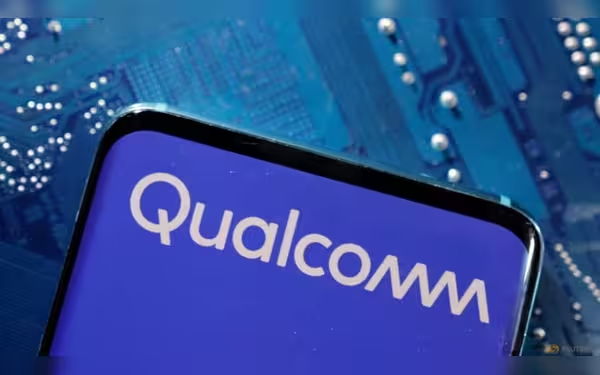Saturday, November 16, 2024 05:33 PM
Qualcomm's Optimistic Forecast Drives 8.5% Surge in Shares
- Qualcomm expects sales to reach $10.90 billion this quarter.
- Shares jumped 8.5% following positive earnings forecast.
- Legal disputes and competition pose challenges for Qualcomm.
 Image Credits: channelnewsasia
Image Credits: channelnewsasiaQualcomm's optimistic forecast leads to an 8.5% surge in shares, driven by strong smartphone sales and new licensing agreements.
Qualcomm, a leading chip designer based in San Diego, California, has recently made headlines with its optimistic forecast for the upcoming quarter. On Wednesday, the company announced that it expects its sales and profits to surpass Wall Street estimates, largely due to a surge in flagship smartphone launches from Chinese manufacturers. This positive outlook has resulted in an impressive 8.5% increase in Qualcomm's shares during extended trading hours.
For the fiscal first quarter, which coincides with the holiday shopping season in the U.S. and Europe, Qualcomm anticipates sales to reach a midpoint of $10.90 billion and adjusted profits of $2.95 per share. In contrast, Wall Street analysts had predicted sales of $10.59 billion and profits of $2.86 per share. This marks a significant improvement from the previous fiscal fourth quarter, where Qualcomm reported sales of $10.24 billion and adjusted profits of $2.69 per share, both figures exceeding analyst expectations.
Qualcomm holds the title of the largest supplier of smartphone chips, and it is currently benefiting from a rebound in the smartphone market. Consumers are increasingly upgrading their devices to take advantage of artificial intelligence applications, such as chatbots and image generators. However, despite the positive outlook, investors remain cautious about the potential decline in revenue from Apple, which is reportedly developing its own modem chips. Qualcomm has warned that Apple may eventually stop using its chips, a move that could significantly impact Qualcomm's revenue, as some analysts estimate that Apple accounts for up to 25% of the company's earnings.
While Qualcomm has secured a deal to continue supplying chips to Apple until at least 2026, the market is closely monitoring the company's efforts to expand into laptops and artificial intelligence in data centers. These initiatives are crucial for offsetting any potential revenue losses from Apple. In its annual filing, Qualcomm disclosed that Apple has started using modem products from one of its competitors, although the specific competitor was not named. Major rivals in the modem market include Taiwan's MediaTek Inc. and South Korea's Samsung Electronics.
On a positive note, Qualcomm's forecast has been bolstered by the launch of new flagship phones from popular Chinese Android brands like Xiaomi, Oppo, and Vivo. Kevin Cassidy, managing director at Rosenblatt Securities, highlighted that these launches have played a significant role in lifting Qualcomm's projections. Additionally, Qualcomm announced a new licensing agreement with Shenzhen Transsion Holdings Co Ltd, a Chinese company that specializes in manufacturing phones for developing markets.
However, Qualcomm is also facing challenges. The company recently ceased shipping 4G smartphone products to Huawei Technologies Co., which previously accounted for approximately $560 million in sales. Furthermore, Qualcomm is embroiled in a legal dispute with Arm, a technology company whose products are integral to Qualcomm's offerings. Arm has threatened to cancel a key license with Qualcomm, and a trial regarding this license dispute is scheduled to begin in December.
In terms of its chip segment, Qualcomm forecasts fiscal first-quarter sales with a midpoint of $9.3 billion, surpassing analyst estimates of $9.02 billion. The company also predicts $1.55 billion in sales from its patent-licensing business, slightly above the $1.51 billion expected by analysts. For the recently concluded fiscal fourth quarter, Qualcomm reported chip and licensing revenues of $8.68 billion and $1.52 billion, respectively, both exceeding estimates.
Qualcomm's strong forecast and the recent surge in its stock price reflect the company's resilience and adaptability in a rapidly changing market. As the smartphone industry continues to evolve, Qualcomm's ability to innovate and expand into new areas will be crucial for maintaining its competitive edge. Investors and consumers alike will be watching closely to see how these developments unfold in the coming months.













